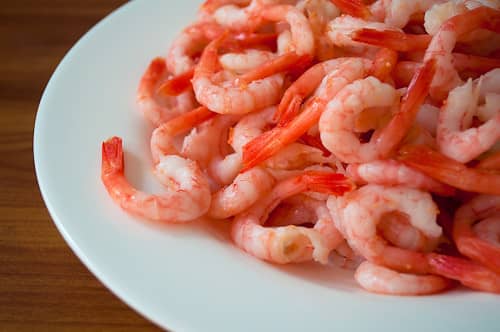
Mastering the art of cooking shrimp begins with understanding the ideal shrimp internal temperature. Achieving this temperature is crucial for both taste and food safety, which we’ll delve into in this article.
Achieving the Ideal Internal Temperature for Shrimp
When it comes to cooking shrimp, precision is key. Reaching the ideal internal temperature of 145°F (63°C) is critical for achieving a delicious and safe shrimp dish. Undercooked shellfish may harbor harmful bacteria, so it’s crucial to get this right.
Importance of Cooking Shrimp to the Correct Internal Temperature
The Food and Drug Administration recommends cooking most seafood to an internal temperature of 145°F (63°C) for at least 15 seconds. This not only ensures that any potential pathogens are killed but also helps preserve the delicate flavor and texture unique to shrimps.
Using a Food Thermometer for Accurate Results
To accurately measure the internal temperature, consider using a food thermometer. It’s easy enough – simply insert it into the thickest part of the shrimp until you reach the desired reading. Remember, properly cooked shrimps turn pink with red tails – another good indicator they’re ready.
Various Cooking Methods for Shrimp
Shrimp, with its delicate flavor and tender texture, can be prepared in a variety of ways. The cooking technique you opt for is dependent on your individual taste and the meal you are making. Regardless of how you decide to cook your shrimp, it’s essential to monitor cooking time carefully to ensure that they reach an internal temperature of 145°F (63°C).
Grilling Techniques for Perfect Shrimp
If grilling is your preferred method, pre-heating at medium heat is recommended. For best results, use larger shrimp when grilling to reduce the risk of them becoming overcooked or slipping through the grill. Additionally, peeling off shells before grilling helps ensure even heating throughout each piece.
- Preheat: Preheat your grill on medium heat.
- Select Large Shrimps: Larger shrimps tend to hold up better on the grill.
- Deshell: Peel off shells prior to grilling for even heating.
Sautéing Methods That Enhance Flavor
Sautéing is another popular way to prepare shrimp. This technique involves quickly frying them in a small amount of hot- usually butter or oil in a sauté pan over high heat. It’s important not only that the pan reaches proper temperature but also seasoning plays a vital role here. Sautéed shrimp recipes often include garlic, butter, and herbs which enhance their natural flavors while providing delightful aroma enhancing overall culinary experience.
- Pan Heat: Ensure the pan reaches the right temperature before adding shrimps.
- Fat Choice: Use butter or olive oil depending upon recipe requirements.
- Seasonings: Garlic, herbs, etc. add extra depth to the taste profile.
Handling Frozen Shrimp Correctly
Knowing how to handle frozen shrimp is crucial for home cooking success. Proper thawing is key to enhancing the final dish. It speeds up browning and preserves the inherent flavors within the meat.
Proper Thawing Process for Frozen Shrimps
For a faster thawing process, place your frozen shrimps in cold water instead of the refrigerator. This slow method ensures that they remain cold enough to inhibit bacterial growth while gradually reaching an ideal temperature for cooking. If you need to speed up this process, submerging your packaged shrimps into cold water can do the trick – just make sure not to use warm or hot water as this could start partially cooking them leading to uneven results later on.
A correctly thawed shrimp will maintain its savory flavor profile and offer a delightful texture with every bite. In contrast, improperly handled frozen shrimps may turn rubbery when cooked or lose their fresh sea taste due to sudden temperature changes, affecting the overall quality of the meal experience.
Impacts of Climate Change on Marine Life and Seafood Preparation
Climate change is messing with our oceans, and it’s not just the fish that are feeling the heat. Rising sea temperatures are causing a ripple effect that could disrupt entire ecosystems, including the seafood we love to eat.
How Climate Change Affects Oceanic Ecosystems
The warming waters caused by climate change are causing changes in water currents and food availability for marine life. This has led to species migrating towards cooler areas, disrupting their traditional habitats and causing an imbalance in local ecosystems.
Besides changing migration patterns, warmer waters also affect reproduction rates and growth cycles of many seafood species. For instance, higher temperatures can speed up the lobster molting process but simultaneously decrease their overall lifespan.
Relation between Changing Sea-Water Temperatures and Seafood Preparation
In addition to ecological impacts, these environmental changes have culinary implications too. As various types of seafood respond differently to heat when cooking – understanding how they adapt biologically becomes crucial from both a taste perspective as well as safety standpoint.
- Lobster: Lobsters prefer colder waters; hence rising ocean temperature might cause them stress leading to poor meat quality upon cooking. Cooking guides suggest maintaining appropriate thermal conditions while preparing lobster dishes for best results. Source
- Codfish: Codfish thrive in cold water environments; thus warmer seas may impact their flavor profile or texture after being cooked. Proper cod preparation tips would help ensure optimal taste despite potential climate-induced changes within fish itself. Source
It’s evident that the alterations in climate are having a major influence on our seas and the seafood we eat.
Conclusion
Don’t get burned by undercooked shrimp! Use a food thermometer to ensure your seafood is cooked to perfection and safe to eat.
Properly thawing frozen shrimp is also key to achieving maximum flavor.
As ocean temperatures continue to change due to climate change, it’s important to consider how this may impact seafood preparation in the future.
Grilling and sautéing are great ways to cook shrimp while maintaining the ideal internal temperature. Get creative with your seafood dishes!

